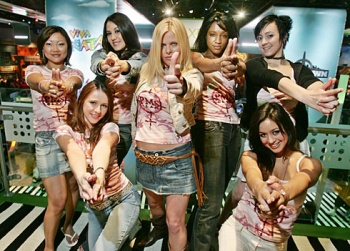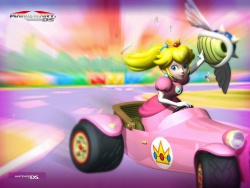Women in Gaming
Women in Gaming is a concept emphasizing women's role, or lack thereof, as video game players or characters. While men have continuously been both the driving force and target audience behind the creation of video games, the female gamer population has grown. Video games are increasingly encompassing characteristics that of female interest, and the gaming environment is slowly becoming a more gender-neutral playing field.[1] The portrayal of women in games becomes ethically charged as gaming's prevalence increases and as virtual images begin to directly mirror the living world.
Contents
History
There are many arguments developed by researchers, software developers, and females alike, that seek to explain why women have been absent from the gaming scene until recent years. Theories include:
- The difference in social characteristics between females and males
- The appeal of game content to women
- How women are portrayed in gaming
Social Constriction
One explanation for women's absence in the history of gaming is that females are inherently more sociable than men. Because gaming is usually seen as an asocial behavior, many believe that it appeals to men more than women. Historically, many women have a greater concern for domestic and/or social activities, rather than leisure activities like gameplay. Therefore, due to other priorities, women have not exerted a much time or effort towards becoming active members of the gaming world; preferring social interaction in the physical world.[2]
Additionally, due to certain social constructs, the male population is more likely to be introduced and have access to games at an early age. According to the studies of Bryce & Rutter, males have traditionally had more access to and control over leisure spaces such as video arcades and sports venues.[3] It has also been argued that males are more likely to learn through action.[2]
Women today still live in a patriarchal society. As a result, men are stereotypically socially constructed to be "powerful," "aggressive," and "strong," while women are "passive" and "quiet".[4] Because of these stereotypes, women tend to play fewer video games, as games have traditionally been marketed as fit for the masculine, violent and aggressive.[5] Men are also usually portrayed as more powerful and aggressive characters in video games, while women are generally represented as less important characters. Because of this, many games have not been appealing to women. The extreme gender stereotyping found in many video games today consists of the absence of female characters, female characters that are less important than male characters, aggression towards female characters, and eroticism of female characters. All of these discriminatory tendencies have produced an environment where female representations fall victim to male supremacy.[6][7][8][5].
Game Content
Historically, the content of games has not always been appealing to women, since games were being marketed predominantly for males. However, game content is changing and more games either encourage women to play or are considered gender neutral. The 1980s brought about drastic changes to the gaming environment, as it introduced several groundbreaking genres, such as adventure, platform, racing and role-playing games. The varying styles of gameplay encouraged a more diverse gamer population, catering to many different interests and skills, but many games today are still of a violent nature.
Stereotypes
Sexualization
- Woman as object of predominantly male desire
- Double-Standard sexual objectivism is applied to women only
- Unrealistic body types
Women as Victims or Objects
- Women are depicted both as the quest object to be saved and as the reward of the self same quest
- Relegated to the status of children
- Difficult for women to identify with both active player and passive object
Gender Stereotyping
- Hostility ("orientalized" view of females/women)[7][8]
- Discrimination (i.e., gender racism or sexism)[9][6][7]
Other
- Cultural conservatism in terms of 'Tradition' [i.e. Tradition of Video Gaming geared, created by and for Males], in a historiographic/nostolgia-sense
- Copycat of video games and in terms of acting out violence toward/against Women [10][9][6][7][8]
- Economic/Money-based "considerations angle" toward all of this
- Theoretical view (i.e. wanting to showcase/market toward females and end discriminatory practices/stereotypes) but in actuality not enough difference in the "bottom-line" (an argumentive-dilemna)
- Lack of "true" proof that girls/females are truly engaged with or into video games (rationale/"excuse" of video-game makers/developers)
Characteristics of Female Characters in Video Games
Absence
Many video games have a lack of female characters or players. Since the creation of video games, female characters have primarily been included in story-lines as objects, and often portrayed as victims. Some examples include: The Legend of Zelda: Occarina of Time where Ganondorf, the antagonist, kidnaps Princess Zelda as part of the story line, and gamers control Link to save her; Super Mario(Series) where Bowser, the antagonist, kidnaps Princess Peach, and gamers control Mario to rescue her; and Teenage Mutant Ninja Turtles where Shredder, the antagonist, kidnaps April O'Neil, and four ninja turtles attempt to save her as a mission.[3]
Abilities
When female characters were first introduced into games populated by male characters, many of them were not given the same or equal abilities. Abilities include mostly skills like speed, strength, or flexibility. For example, in Super Smash Brothers, female characters, such as Princess Peach and Samus, are often slower or less powerful than their male counterparts. However this is not always true. In the 1993 game Super Mario Bros. 2, Princess Peach had the unique ability of flotation, allowing her to make jumps that the other characters could not.[11].
Aggression
Many video games also depict aggression towards female characters. Some games, such as Quake and Doom, have been accused of crossing a line with the inclusion of dialogue and actions that enable sexual harassment towards women. [6][9][8][5]
Eroticisation
Another criticism of video games is the unrealistic representation and objectification of female characters. For example, Lara Croft from the game Lara Croft: Tomb Radier, has unrealistic, arguably impossible, body proportions. [6]
Certain video games developers have gone to great lengths to sexually objectify female characters. Developers from the fighting game series Dead or Alive focused heavily on creating accurate breast physics and increasing the sexual appeal of female characters in the fifth iteration of the game.[12].
Emergence of Female Gaming Culture
First Female Games
In 1997, Mattel released Barbie Fashion Designer, one of the first games that targeted a female audience. Barbie Fashion Designer sold over 600,000 copies and is considered to be the first entertainment software to capture a mass female market. The tremendous success of this game started a movement towards the development and production of games designed specifically for girls. Applications such as Barbie Fashion Designer, American Girl interactive software, and the Nancy Drew adventure games did remarkably well and their success is attributed to the high appeal of real life, everyday characters to the female population. [2]
Women in Gaming Today
While studies confirm that men still dominate the virtual gaming world, women are becoming a more active part of the community. According to the Entertainment Software Association, roughly 40% of all video game players are female.[13] In addition, the female population represents over 43% of online players and are the fastest growing demographic in the gaming industry.[7]. These subclasses of female gamers can be defined as Power-gamers, Moderate-gamers and Non-gamers. [7]
Women in Professional Gaming
The PMS (Pandora's Mighty Soldiers) clan was formed in 2002 by twin sisters Amber Dalton and Amy Brady. The PMS clan has an international roster of over 500 women, and is one of several professional female gaming organizations.
In August of 2004, a team of professional female gamers around the United States formed The Frag Dolls. They had been recruited by Ubisoft, who wanted to promote their games and represent the presence of women in the game industry. The Frag Dolls have participated in many gaming events and tournaments. Their popularity grew after they won the Rainbow Six 3: Black Arrow tournament in 2004, and in 2007, they ranked 11th place overall in the Major League Gaming season in Rainbow Six Vegas making them the first all-female team to make Semi-Professional status in Major League Gaming history.[14]
Acceptance of Female Gamers
X-play
The long time host Morgan Webb of the G4's show on computer games, x-play, was initially viewed not as a gamer but as a television personality. As the host of the show, many thought she had been added for her looks, not her gaming ability. Many made this opinion clear in fan mail sent to Webb. It is unclear what caused the shift in perception, but Webb now garners bona fide gamer status.
Professional Female Gamers
On June 14, 2011, the professional StarCraft II team SlayerS Clan added Eve, the first female professional gamer, to their roster. [15] Many SlayerS and StarCraft II fans were outraged by the new addition to the team roster, as they felt that Eve was under qualified compared to the other members of SlayerS and that she was simply recruited due to her gender. Eve began receiving numerous inappropriate and abusive tweets and letters from anti-fans, which led the SlayerS team manager to resort to legal action against many of those who harassed Eve.
Video Games with Female Main Characters
Examples of female characters in video games:
Preferences
Studies by research groups such as the American Association of University Women Educational Foundation Commission on Technology, Gender and Teacher Education, reveal that female preferences in games include:
- Collaboration
- Communication
- Positive action
- Challenge
- Use of strategies and skills
- Ability to design and create
- Adventure
Many games, especially online games, are beginning to adopt some of these characteristics, in an attempt to draw in greater female participation. For example, EverQuest (EQ) provides appropriate levels of challenge, collaboration, communication, self-selection of roles, and exploration.[1]
Ethical Concerns
Image and Identity
The ethical concerns in portraying women in gaming revolve around projection and perception. Both work inform gamers of accepted social roles for women, how women should be viewed, and what women should look like. While the link between virtual violence and real violence has proven to be illusive, issues of womens' self-identity can be linked to the way in which women are portrayed in media. Females have continuously been exposed to gender stereotypes through commercial advertisements, movies, games, and other media.
Technological Literacy
Computer games are often the first form of interaction children have with technology. These games are likely to promote an interest in technology, among both genders, and can serve as a direct lead-in to computer literacy. However, there is some concern as to whether this apparent correlation between gaming and computer literacy will place females at a disadvantage, not only in their educational experience but in their future career endeavors.[2]
Past trends have indicated that males adopt gaming habits early in their adolescence, while females often do not start using games until they are young adults. This delayed entrance into the gaming environment could extend the time or education required for a female to become proficient with computers and technology. In addition, lack of video game use among females could have even greater implications on career interests and choices. If the desire to better understand technology does not emerge early in females, it is likely that the IT Industry will continue to be dominated by men.
References
- ↑ 1.0 1.1 The MIT Press: "Play Between Worlds" Taylor, T.L. (2003). “Multiple Pleasures: Women and Online Gaming,” Convergence, v.9, n.1.
- ↑ 2.0 2.1 2.2 2.3 MITCogNet Website: "From Barbie to Mortal Combat" Cassell, J and Jenkins, H. (eds) (1998). "From Barbie to Mortal Kombat: Gender and Computer Games". Cambridge, MA: The MIT Press.
- ↑ 3.0 3.1 Bryce, J. & Rutter, J. (2002). “Killing Like a Girl: Gendered Gaming and Girl Gamers’ Visibility” in CGDC Conference Proceedings, F. Mayra (ed.). Tampere: Tampere University Press. http://digiplay.info/files/cgdc.pdf
- ↑ Oneonta Website: "The Social Construction of Website" http://www.oneonta.edu/faculty/farberas/arth/arth200/gender.html
- ↑ 5.0 5.1 5.2 SciVerse Website: "Video Game Violence: A review of the empirical literature" http://www.sciencedirect.com/science/article/pii/S1359178997000013/
- ↑ 6.0 6.1 6.2 6.3 6.4 "Education Resources Information Center Website: "Girl Gamers: The Controversy of Girl Games and the Relevance of Female-Oriented Game Design for Instructional Design" http://www.eric.ed.gov:80/ERICWebPortal/custom/portlets/recordDetails/detailmini.jsp?_nfpb=true&_&ERICExtSearch_SearchValue_0=EJ739503&ERICExtSearch_SearchType_0=no&accno=EJ739503 Dickey, M.D. (2006) 37(5). 785-793.
- ↑ 7.0 7.1 7.2 7.3 7.4 7.5 SAGE Journals Website: Violent Video Games and Hostile Expectations: A Test of the General Aggression Model. Royse, Pam. (2007). "Women and games: technologies of the gendered self". Los Angeles, London, New Delhi, and Singapore. SAGE Productions.http://nms.sagepub.com/cgi/content/abstract/9/4/555
- ↑ 8.0 8.1 8.2 8.3 Hein Online: "Mediated Images of Violence and the First Amendment: From Video Games to the Evening News" http://heinonline.org/HOL/Page?handle=hein.journals/maine57&div=10&g_sent=1&collection=journals/
- ↑ 9.0 9.1 9.2 SciVerse Website: "Effects of Violent Video Games on Aggressive Behavior: Potential Sex Differences" http://www.sciencedirect.com/science/article/pii/S0022103101915021/
- ↑ Wiley Online Library: "Mortal Kombat" http://onlinelibrary.wiley.com/doi/10.1111/j.1559-1816.1996.tb02740.x/abstract
- ↑ Wikipedia: Super Mario Bros. 2 http://en.wikipedia.org/wiki/Super_Mario_Bros._2
- ↑ Team Ninja goes hands-on with breasts to create 'the cutest chicks in videogames' [1]
- ↑ The Entertainment Software Association Website http://www.theesa.com/
- ↑ Frag Dolls Website: About Section http://www.fragdolls.com/index.php/gamer-girls
- ↑ Team Liquid Website: StarCraft 2 http://www.teamliquid.net/forum/viewmessage.php?topic_id=243800





















